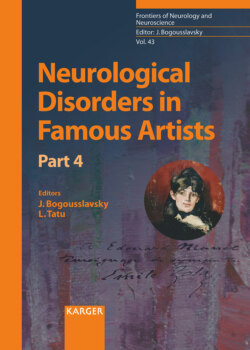Читать книгу Neurological Disorders in Famous Artists - Part 4 - Группа авторов - Страница 40
На сайте Литреса книга снята с продажи.
Georges Braque: The Trepanned Painter
ОглавлениеAfter studies to become a painter-decorator in Paris, George Braque decided to devote himself to painting. Close to the artists of the Parisian avant-garde and to Guillaume Apollinaire, he was first interested in fauvism and befriended Pablo Picasso (1881–1973) during the peak period of cubism.
Braque was mobilized in the French army and became a sergeant at the end of 1914 in the 329th infantry regiment. He served on the Somme frontline close to the trenches where his friend, the Swiss writer Blaise Cendrars was fighting: “…Ah, had I known that, I would have been there to shake the hand of my good friend Braque” [Cendrars, 2013, p. 649] (Fig. 3).
Becoming an officer in the 224th infantry regiment, Braque was involved in the Artois offensive in the spring of 1915. As a commander, he had little time to draw, unlike other mobilized painters who brought back hundreds of drawings from the trenches. On May 11th, 1915, during the Neuville-Saint-Vaast offensives in the North of France, Braque’s head was hit by shrapnel. His metal helmet, only recently delivered to the French army, saved his life. Nevertheless, Braque was left for dead on the battlefield. He was eventually evacuated to the rear of the frontline by stretcher-bearers, suffering from a severe head injury.
Braque’s medical report detailed that he was first treated in a field ambulance and was later hospitalized, on May 30th, 1915, in the militarized Hôtel Meurice in Paris. Upon admission, he was diagnosed with the following: “Skull fracture in left fronto-parietal region. Trepanation” (Dossier Georges Braque; Service des Archives Médicales et Hospitalières des Armées, SAMHA, Limoges, France). Regarding the severity of his wound, it is likely that Braque was trepanned by the surgeon of the field ambulance to evacuate an extradural or an epidural hematoma. In July 1915, he was transferred to a military hospital in Bois-Colombes and was eventually discharged in 1917. Like most First World War wounded soldiers, Braque began a long procedure to obtain an invalidity pension. The archives related to this procedure detail his injury: a 4- by 1-cm groove in the left frontoparietal part of the skull, creating a pulsating scare (Archives Départementales de Seine-Maritime, fiche matricule de Georges Braque, 1R 3113, Rouen, France).
Braque progressively returned to civilian life. On January 14th, 1917, the Russian painter Marie Vassilieff (1884–1957) organized a banquet to celebrate his return. Cendrars, Picasso, and Henri Matisse (1869–1954) were invited to this dinner which was immortalized in a famous painting. The return to artistic practice was difficult for Braque: “I have suffered not only from the injury but also from being unable to paint for months. The mind was more affected than the body” [Danchev, 2013, p. 131]. These depressive symptoms were mainly related to his posttraumatic syndrome but also to the loss of brain substance due to the injury. Nevertheless, Braque resumed his artistic activities during his hospitalization to paint La Joueuse de Mandoline (Lille Métropole Museum of Modern, Contemporary and Outsider Art, LaM, Villeneuved’Ascq, France). This painting is an ambitious cubist portrait which does not show any artistic break with his prewar works. It announces one of his main paintings of that period, La Musicienne (Kunstmuseum, Basel, Switzerland), begun in 1917.
After his injury, Braque, like many painters, remained silent about the war, which is never featured in his work. He focused on art, grew closer to the painter Juan Gris (1887–1927), and started to write his reflections on painting [Braque, 1917].
